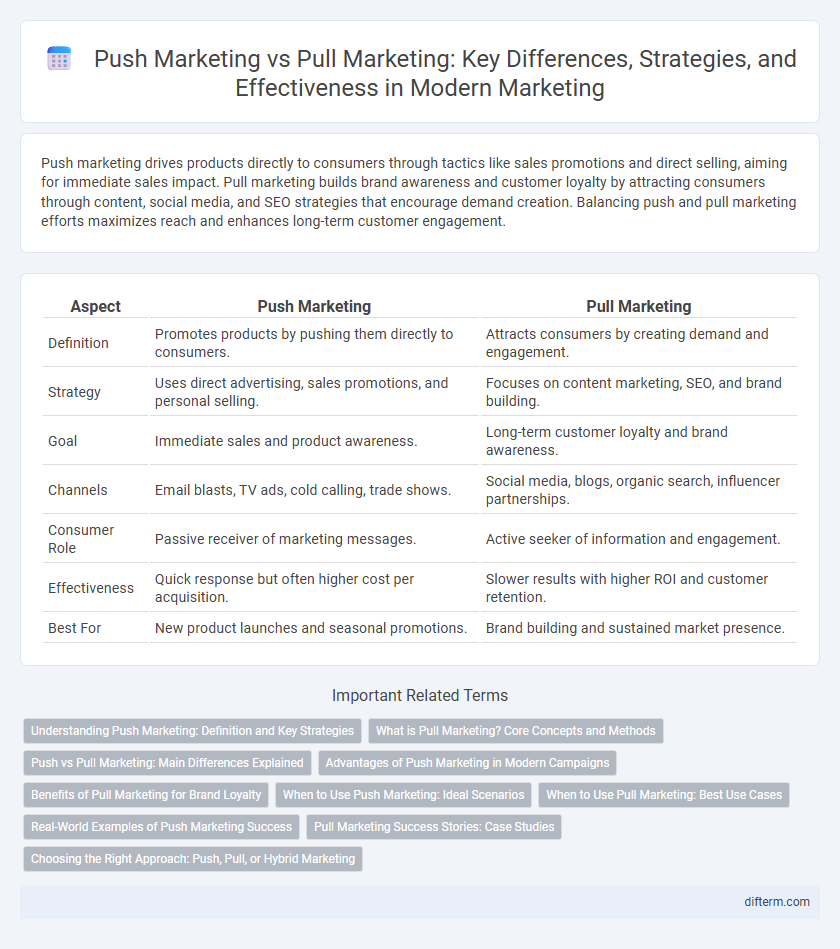Push marketing drives products directly to consumers through tactics like sales promotions and direct selling, aiming for immediate sales impact. Pull marketing builds brand awareness and customer loyalty by attracting consumers through content, social media, and SEO strategies that encourage demand creation. Balancing push and pull marketing efforts maximizes reach and enhances long-term customer engagement.
Table of Comparison
| Aspect | Push Marketing | Pull Marketing |
|---|---|---|
| Definition | Promotes products by pushing them directly to consumers. | Attracts consumers by creating demand and engagement. |
| Strategy | Uses direct advertising, sales promotions, and personal selling. | Focuses on content marketing, SEO, and brand building. |
| Goal | Immediate sales and product awareness. | Long-term customer loyalty and brand awareness. |
| Channels | Email blasts, TV ads, cold calling, trade shows. | Social media, blogs, organic search, influencer partnerships. |
| Consumer Role | Passive receiver of marketing messages. | Active seeker of information and engagement. |
| Effectiveness | Quick response but often higher cost per acquisition. | Slower results with higher ROI and customer retention. |
| Best For | New product launches and seasonal promotions. | Brand building and sustained market presence. |
Understanding Push Marketing: Definition and Key Strategies
Push marketing involves actively promoting products to consumers through direct channels such as sales promotions, trade shows, and advertisements to create immediate demand. Key strategies include using aggressive sales techniques, in-store displays, and targeted email campaigns to push products onto customers. This approach emphasizes controlling the consumer journey and rapidly increasing product visibility within the marketplace.
What is Pull Marketing? Core Concepts and Methods
Pull marketing centers on attracting customers by creating valuable content and experiences tailored to their needs, encouraging them to seek out a brand independently. Core methods include content marketing, SEO, social media engagement, and influencer partnerships, all designed to build long-term relationships and brand loyalty. This strategy enhances customer trust and drives organic traffic by meeting consumer demand through relevant and informative communication.
Push vs Pull Marketing: Main Differences Explained
Push marketing involves proactively delivering products or messages to consumers through channels such as direct sales, email campaigns, or retail displays, targeting immediate customer acquisition and sales. Pull marketing focuses on creating demand by attracting customers through content marketing, SEO, and social media engagement, encouraging consumers to seek out the brand organically. The primary difference lies in push marketing's outbound approach versus pull marketing's inbound strategy, each impacting customer interaction and brand loyalty differently.
Advantages of Push Marketing in Modern Campaigns
Push marketing enables businesses to deliver targeted promotions directly to consumers, increasing immediate product visibility and boosting short-term sales. This approach is highly effective for new product launches and limited-time offers, ensuring messages reach potential buyers before competitors. Leveraging channels such as email campaigns, direct mail, and in-store displays optimizes customer engagement and accelerates the purchasing decision process.
Benefits of Pull Marketing for Brand Loyalty
Pull marketing enhances brand loyalty by attracting customers through engaging content and personalized experiences that build trust and emotional connection. This strategy encourages repeat purchases by fulfilling customer needs proactively, leading to higher retention rates and long-term brand advocacy. By fostering genuine interest, pull marketing reduces reliance on aggressive sales tactics, resulting in a more sustainable and positive brand reputation.
When to Use Push Marketing: Ideal Scenarios
Push marketing is ideal for new product launches, clearance sales, or when targeting specific customer segments with direct promotions. It effectively drives immediate sales by actively presenting the product through channels like trade shows, direct emails, or retail displays. Brands use push strategies to quickly build awareness and generate short-term demand in competitive markets.
When to Use Pull Marketing: Best Use Cases
Pull marketing is most effective when targeting informed consumers actively seeking specific products or services, such as during brand awareness campaigns or product launches. It excels in industries with high customer involvement, like technology or luxury goods, where content marketing and SEO attract qualified leads. Utilizing pull marketing strategies is ideal for building long-term customer relationships and driving organic traffic through valuable, targeted content.
Real-World Examples of Push Marketing Success
Push marketing strategies have driven success for brands like Procter & Gamble, whose extensive in-store promotions and direct retailer partnerships boosted product visibility and sales. Consumer electronics companies such as Samsung effectively use push tactics by placing products prominently in retail outlets and engaging in aggressive advertising campaigns to capture immediate customer interest. These examples demonstrate push marketing's power in creating demand through direct communication and strategic distribution channels.
Pull Marketing Success Stories: Case Studies
Brands like Apple have excelled in pull marketing by creating strong customer demand through innovative products and compelling storytelling, driving organic traffic and engagement. Coca-Cola's personalized campaigns leverage emotional connections and social media interactions, resulting in heightened brand loyalty and increased sales. These case studies highlight how pull marketing effectively attracts customers by aligning brand values with consumer interests, fostering long-term relationships.
Choosing the Right Approach: Push, Pull, or Hybrid Marketing
Effective marketing strategies require selecting between push, pull, or hybrid approaches based on target audience behavior and product type. Push marketing emphasizes proactive promotion through channels like direct sales and trade shows to quickly build awareness and demand. Pull marketing leverages content marketing, SEO, and social media to attract customers organically, fostering long-term engagement and brand loyalty.
push marketing vs pull marketing Infographic

 difterm.com
difterm.com